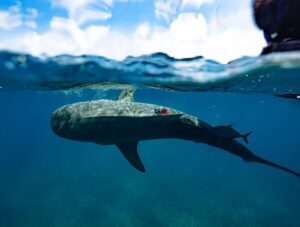First, let me start by saying that it is important to remember that human civilization is not the center of the universe. Yet, for the last few thousand years, we’ve been acting as if we were… and that has led to sobering consequences.
Humanity today faces what are arguably the two biggest challenges to the existence of our species: human-induced climate change and the planet’s biodiversity loss. But before you dismiss this as another article that contains nothing but doom, gloom, and nihilism, stop.
Because you’d be wrong.
We have never been better equipped to face these interconnected and existential crises. We have the collective knowledge, the technology, and—most critically— the opportunities to form a new partnership with nature, one that could unlock our planet’s biggest secrets and reconnect the ever-desired and sustainable closed loop system.

Me diving with a tiger shark patrolling the Bahama Banks; a gentle reminder that we are not the center of the universe.
This is our chance to redefine humanity’s role within Earth’s grand narrative and give life a fighting chance.
But first, a quick summary of the current state of affairs.
The State of Our Planet
Climate
Our planet is in a feverish state. Today, global atmospheric carbon dioxide measures over 417 parts per million (ppm). To put this into perspective, the average pre-industrial level was about 280 ppm. For the eleventh year in a row, this bellwether measurement has increased by more than 2 ppm. In tallying all of mankind’s cumulative greenhouse gas emissions (GHGs), more than half of our total emissions have been emitted since 1990 – a mere three decades (1).
As I am writing this article, the 37 hottest days in the past 120,000 years have been the prior 37 days. The ocean off the coast of Florida is measuring 101.5 °F, a perpetual hot tub jet a full five feet underwater (2).
These staggering statistics are likely figures that you know by heart or have heard on the news in recent years as their impacts are starting to be felt with more frequency. What you may not know is that over 25% of all human-caused GHGs are directly attributed to the destruction of nature (3). It’s not simply our cars and factories, but the deforestation, defaunation, and rampant habitat destruction that we are inflicting on Earth.
While we largely understand the issues around unabated emissions and the inherent problems that our addiction to fossil fuels cause, we are seemingly powerless or, perhaps more troubling, unwilling, to stop this trend.
Biodiversity
For hundreds of millions of years, nature has been relentlessly evolving, iterating, and reiterating – “survival of the fittest” may be the term that first comes to mind. Competition between species is the single biggest evolutionary force, producing the genetic diversity necessary for nature to protect itself from unforeseen, but inevitable, threats.
In essence, nature is a supercomputer that is perpetually running a global algorithm to create the most efficient and diverse strings of genetic code, distributing and recycling resources through time and space.
Under normal circumstances, the balance produced by competition results in a healthy and functioning system, with new species evolving as others naturally fade away. Aside from five mass extinction events in the past 500 million years, the background rate of extinction (commonly represented as extinctions per species per year) has been roughly two mammalian extinctions per 10,000 species per 100 years (3).

Up close and personal with over 13 million years of evolution and one of the planet’s best competitors.
We are no longer in normal circumstances.
The best-case-scenario is that today’s extinction rate is well over 100 times that of the background rate, with this calculation amplifying and increasing every year. The number of species that the planet has lost in just the last century alone should have taken 10,000 years to disappear (4).
We are most undoubtedly experiencing the planet’s sixth mass extinction.
Most humbling of all is the fact that in none of the prior five mass extinctions has one species been the cause of the planet’s system-wide collapse.
Innovate or Perish: Our Path Forward
I often find myself analyzing the historical trends of the last century through the tried-and-true business adage: innovate or die. Now more than ever, this wisdom rings true to me. A static system will undoubtedly face collapse in-light-of ever-evolving challenges. Our relationship with the natural world must now innovate, or we risk the perils of a dead planet.
Accounting for Nature’s Value
At the heart of our environmental crises lies a counterintuitive imbalance: how our global economic systems value nature’s productivity.

Nature’s bounty on the Little Bahama Bank – this seagrass meadow stores over 1 billion tons of CO2.
Consider, for instance, planetary carbon cycling. What is the monetary contribution of the Amazon rainforest to annual GDP through water filtration, carbon sequestration, and biodiversity support? A tricky question to answer. What was Brazil’s overall GDP growth in 2022? A quick google search can answer.
While we consistently track conventional economic indicators, we simply do not account for the essential services that our ecosystems provide to our species every day.
It is time to envision a new kind of ledger. In the simplest of terms, we must reharmonize with the planet’s own accounting systems.
What if we found a way to take the excess carbon that humans have emitted into our atmosphere and inject it back into nature? This alone would solve over 37% of our GHG drawdown requirement (5).
This solution exists, and it is colloquially termed “rewilding.”
We can solve our species’ market-based problems with nature-based solutions and nature-based accounting. By institutionalizing global accounting methods that properly value the services that nature provides, we can avoid being the cause of the sixth mass extinction on this planet.
We can avoid being a victim of our own destruction.
The Symbiotic Future
Innovation and cutting-edge science, combined with strategic partnerships with nature, offer a perpetual space of hope as our species looks to the future. Let me tell you a personal example from the tropical waters of the Caribbean.
Just last year, a team of researchers at Beneath The Waves teamed up with tiger sharks in The Bahamas to discover the largest seagrass meadow on Earth.
By equipping these apex predators with underwater video cameras, we launched a collaborative partnership with nature that empowered tiger sharks to become the oceanographers of previously unexplored parts of our ocean. By combining technology with nature – in this case with an often feared and misunderstood keystone species – mankind discovered a vital clue and a global asset in the fight against climate change and biodiversity loss.

Beneath The Waves’ most efficient collaborator.
Could it be that species that have evolved on our planet for hundreds of millions of years hold ancient knowledge that we have yet to discover?
In The Bahamas, tiger sharks certainly did. They catalyzed a first-of-its kind carbon finance project and established new protections to safeguard one of the largest pools of sequestered carbon on Earth for generations to come.

Tiger sharks spend over 70% of their time in The Bahamas patrolling seagrass habitat.
What further clues might nature hold if we dive into its other secrets?
What Dr. Ian Malcolm Should Have Said
This brings us to the fundamental building block of life: genetics
What was once the lore of science fiction novelists – tools that map and edit genetic code – have today become reality. Innovation at the bleeding edge of genetics will undoubtedly provide humanity with its biggest opportunity to partner with nature and create new, nature-based economies.
Enter Colossal Biosciences’ ambitious goal to Make Extinction a Thing of the Past.

The power to prevent the loss of biodiversity on a large scale is finally in our hands. By harnessing bioscience, we can turn back the clock to a time when Earth breathed easier.
Working with, and protecting, threatened species will allow us to reestablish a symbiotic relationship with the planet and preserve knowledge that would otherwise be lost forever. If we have any hope of solving our own plights and rectifying our misalignment with nature, humanity must look to the genetic clues in the millions of other successful species on the planet.
By forging one step deeper and reviving extinct species, we may further unlock ancient clues that both benefit our biosphere through their rewilding and, simultaneously, warn us about the perils of innovating too late in the face of a changing environment.
If we are willing to adapt and entrench a paradigm shift within our relationship with nature, the mammoth’s once pivotal role in regulating the tundra’s carbon cycle and biodiversity may once again become an ally in solving one of humanity’s biggest challenges.

Can the de-extinction of keystone species restore ecosystems and become mankind’s best climate-fighting allies?
So, how will we mitigate the threat of runaway climate change and simultaneously avert a sixth mass Holocene extinction? As the old saying goes, we must innovate or die… or, if I may be so bold as to rewrite a classic quote from my childhood hero, Jurassic Park’s Dr. Ian Malcolm, “[if given a chance,] life finds a way.”
We must give life a chance.

Wells Howe
About Wells Howe
 Wells leads Beneath The Waves’ Blue Carbon program which focuses on conservation efforts across the globe through the deployment of proprietary Blue Carbon methodologies. His endeavors have led through both the financial for-profit and non-profit sectors, launching new-to-market renewable energy solutions, building leveraged carbon finance impact assessment and optimization tools, and launching multiple ocean de-carbonization solutions.
Wells leads Beneath The Waves’ Blue Carbon program which focuses on conservation efforts across the globe through the deployment of proprietary Blue Carbon methodologies. His endeavors have led through both the financial for-profit and non-profit sectors, launching new-to-market renewable energy solutions, building leveraged carbon finance impact assessment and optimization tools, and launching multiple ocean de-carbonization solutions.
Learn more about Colossal’s Advisors
REFERENCES
1. Lindsey, Rebecca. “Climate Change: Atmospheric Carbon Dioxide.” NOAA Climate.Gov, 12 May 2023, www.climate.gov/news-features/understanding-climate/climate-change-atmospheric-carbon-dioxide.
2. Thompson, Andrea. “July 2023 Is Hottest Month Ever Recorded on Earth.” Scientific American, 27 July 2023, www.scientificamerican.com/article/july-2023-is-hottest-month-ever-recorded-on-earth/.
3. Le Quéré, C., et al. “Global Carbon Budget 2014.” Earth System Science Data, Copernicus GmbH, 8 May 2015, essd.copernicus.org/articles/7/47/2015/.
4. Ceballos, Gerardo, and Paul R Ehrlich. “Accelerated Modern Human–Induced Species Losses: Entering … – Science.” Science , 19 June 2015, www.science.org/doi/10.1126/sciadv.1400253.
5. Griscom, Bronson W, et al. “Natural Climate Solutions.” PNAS, 5 Sept. 2017, www.pnas.org/doi/10.1073/pnas.1710465114.



